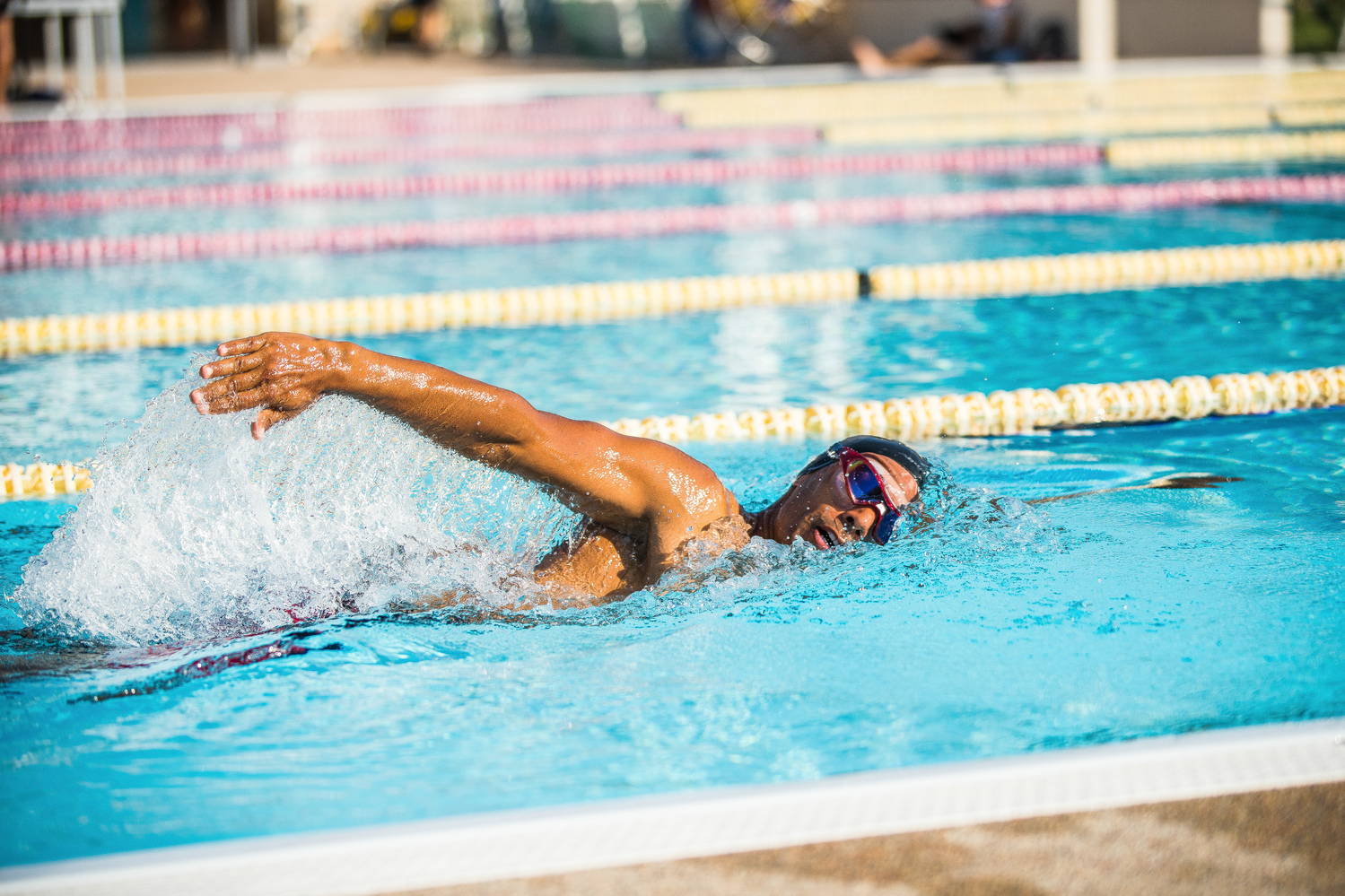Den Arm in der Überwasserphase gestreckt lassen, die Fingerspitzen in Kopfhöhe eintauchen und mit gespreizten Fingern den Zug durchziehen – das hört sich nicht nach einem ökonomischen Schwimmstil an, ganz im Gegenteil! Dennoch ist es sinnvoll, übertriebene Bewegungsabläufe in das Schwimmtechniktraining zu integrieren. Wir haben Tipps und Übungen für euch.
Mit solchen Kontrastübungen lassen sich Gegensätze erfahrbar machen – das Ziel ist eine Verbesserung des Wassergefühls und vor allem das „Aha-Erlebnis“: Ihr als Schwimmer sollt selbst erkennen, welcher Bewegungsablauf der sinnvollste ist.
AHA-Erlebnisse beim Schwimmen
Das Techniktraining im Schwimmen ist im Triathlon meist sehr direkt gestaltet. Beispiel: Der Schwimmer entspannt den Arm in der Überwasserphase zu wenig? Dann soll er auf einen hohen Ellenbogen achten oder den Arm über Wasser ausschütteln. Diese Korrektur bzw. Übung ist allerdings von außen vorgegeben, dem Schwimmer fällt es meist schwer, den automatisierten Ablauf zu durchbrechen und den Arm zu entspannen.
Kontrastübungen geben die Lösung nicht vor. Dem Schwimmer wird vielmehr eine Aufgabe gestellt: "Schwimme 25 Meter mit durchgestrecktem Arm in der Überwasserphase („Windmühle“), schwimme dann 25 Meter mit maximal angewinkeltem Ellenbogen und schließe den Durchgang mit 25 Metern lockerem Kraul ab."
Das Wichtigste dabei
Konzentriere dich zu 100% auf diese Bewegung, spüre, wie sich die Bewegung (mit dem Wasser) anfühlt und welchen Einfluss diese Armhaltung auf deinen Vortrieb und deine Ermüdung hat und reflektiere danach deine Erfahrungen.
Mit Kontrastübungen lässt sich also keine direkte und schnelle Technikkorrektur erzielen. Vielmehr geht es um die Schulung von Wasser- und Bewegungsgefühl, Koordination und um eine Verbesserung der Kinästhesie (Erklärung). Dies sind wesentliche Voraussetzungen für die Umsetzung einer guten Technik im Wasser. Wer Kontrastübungen in sein Training einbaut, arbeitet also am Fundament der Technik. Dazu sind weder Hilfsmittel noch große Techniktrainingsblöcke nötig.
Nachteil: Während man sich auf einen einzigen Teil der Bewegung konzentriert, können sich andere Fehler in den Bewegungsablauf einschleichen!
Nahezu jeder „Fehler“ in der Schwimmbewegung kann durch Kontrastübungen aufgearbeitet werden und bringt als Mehrwert ein verbessertes Wassergefühl.
Auch interessant
Einige Beispiele für Kontrastübungen:
- Für das Wasserfassen und die Handhaltung: Faustschwimmen vs. mit gespreizten Fingern schwimmen.
- Das Handgelenk starr halten vs. das Handgelenk ganz locker lassen.
- Für die Überwasserphase: Arm über Wasser komplett gestreckt lassen („Windmühlenschwimmen“) vs. Arm starr angewinkelt lassen.
- Für das Eintauchen: Arm auf Höhe des Kopfes eintauchen vs. Arm maximal weit vorne eintauchen.
- Für die Unterwasserphase: Durchgestreckter Armzug vs. stark angewinkelter Ellenbogen während des Zuges.
- Ende des Zuges auf Höhe der Brust vs. Ende des Armzuges auf Höhe des Knies.
- Für die Kopfhaltung: Kinn zur Brust nehmen vs. Kopf in den Nacken nehmen.
- Nackenmuskulatur komplett entspannt lassen vs. Nackenmuskulatur starr anspannen.
- Für die Atmung: Kopf komplett aus dem Wasser reißen vs. Kopf nur minimal drehen.
- Körper komplett mitdrehen vs. Körper beim Atmen gar nicht bewegen.
- Für die Körperspannung: Abstoßen und Körper komplett locker lassen vs. Abstoßen und Körper starr halten.
- Für die Fußhaltung: Zehen anziehen vs. Fuß komplett strecken.
- Für den Beinschlag: Beinbewegung aus den Knien („Radfahrerbeinschlag“), Knie komplett gestreckt lassen.
- Kleine Beinbewegungen mit hoher Frequenz vs. große Beinbewegungen mit niedriger Frequenz.
Beispiele für die Gestaltung eines Technikabschnitts
Kontrastübungen lassen sich am besten direkt nach dem Einschwimmen und vor dem Hauptprogramm durchführen. Tempo und Streckenlänge sind gering, 25 Meter-Abschnitte reichen auch für die besseren Schwimmer. Wichtig: Nach jeder übertriebenen Bewegung sollte direkt im Anschluss die „normale“ Bewegung durchgeführt werden. Mehr als zwei „Baustellen“ pro Trainingseinheit solltet ihr nicht bearbeiten, konzentriert euch lieber intensiver auf wenige Probleme! Entscheidet euch, ob ihr nur einen Kontrast setzt oder auch den zweiten mit einbezieht: Wenn also das Schwimmen mit der geschlossenen Faust „Kontrast 1“ ist, ist das Schwimmen mit gespreizten Fingern „Kontrast 2“. Im Folgenden findet ihr einige Vorschläge für Technikblöcke mit Kontrastübungen:
- 2x(4x50m): Im ersten Viererblock je 25 Meter Kontrast 1 (K1) und 25 Meter Ganze Lage (GL), im zweiten Block je 25 Meter Kontrast 2 (K2) und 25 Meter GL
- 6×75 Meter: Je 25 Meter K1, K2 und GL
- 10×75 Meter, für Fortgeschrittene: 25 Meter mit dem rechten Arm K1 und mit dem linken Arm K2. 25 Meter mit dem linken Arm K1 und mit dem rechten Arm K2. Anschließend 25 Meter GL.




















